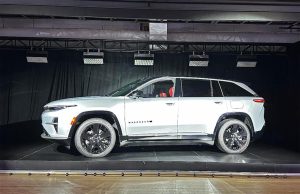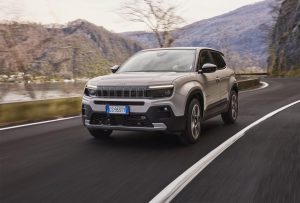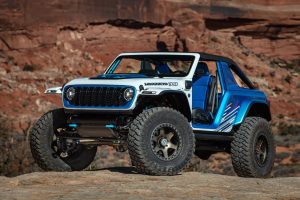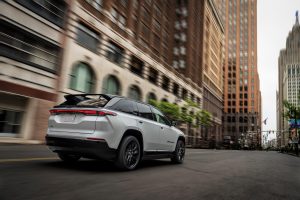The Jeep brand just launched its first EV for the U.S. market but more are on the way – including a $25,000 all-electric SUV that should be on sale “very soon,” according to Carlos Tavares, CEO of Jeep parent Stellantis.
The Jeep Grand Wagoneer S made an auspicious debut in New York last week and ushers in a major shift in direction for the off-road arm of Stellantis, with an assortment of “electrified” and all-electric models set to come to market over the next few years.
The Wagoneer S, the first Jeep EV for the U.S. market, won’t come cheap, at $71,995 before delivery fees for the initial Launch Edition. Less expensive models are in the works, but they’ll still be well above what the average $55,000 that the typical EV went for in the U.S. last month, according to Kelley Blue Book. And that’s nearly $10,000 more than what the typical U.S. motorist pays for conventional gas models.
The high cost of an EV is one of the key reasons why the growth of the EV market has sharply slowed this year, KBB analysts report. But among the products Jeep has coming, at least one will target a more “affordable” segment, according to Stellantis CEO Carlos Tavares.
Coming “very soon” to a Jeep showroom near you
Speaking at a Bernstein investor conference, the Portugese-born Tavares said Jeep is developing a new EV that will come in around $25,000. And he hinted that it will arrive in U.S. showrooms “very soon.”
“If you ask me what is an affordable BEV, I would say 20,000 euros in Europe and $25,000 in the U.S.,” Tavares said. “So our job is to bring the safe, clean and affordable BEV to the U.S., $25,000. We’ll do it.”
Tavares didn’t offer many details about this “affordable” EV, but it could be a significant development considering there are few all-electric products available in the U.S. for less than $35,000, and all but a small handful under $30,000. The base model of the new Chevrolet Equinox EVcoming later this year will come in as low as $27,495 – but that will only be after factoring in $7,500 in federal tax credits.
It’s unclear whether the promised $25,000 starting price for the new Jeep EV will be based on similar tax credits. If so, that would require it to meet various local sourcing and production mandates. Among other things, the vehicle would need to be assembled in the U.S., Canada or Mexico and use batteries – and their raw materials – sourced from either the NAFTA region or from a handful of approved trade partners.
Avenger
No details have been offered concerning the size, range or power of the affordable Jeep, among other specifics. But comments Tavares made at the Bernstein event could offer some clues.
Wagoneer S is actually the second EV from Jeep, though the Avenger is not available in the U.S. market.
It’s offered in multiple forms, including a plug-in hybrid starting at $25,950, after adjusting for current exchange rates. But jumps to $41,090 in all-electric form. While that’s more affordable than most current U.S. EVs, Tavares stressed he doesn’t see a real market here, in large part because Avenger is too small. It’s a B-, or subcompact, model which is a perfect size for the typical European buyer. That size class is far smaller in the U.S., and all but absent in the EV segment. Americans generally prefer compact, or C-sized, SUVs, including EVs.
More EV News
- Jeep Unveils the All-Electric Wagoneer S
- Jeep Wagoner S Trailhawk Concept Takes Battery Power Off-Road
- First Drive: 2024 Chevrolet Equinox EV
What will we get for $25,000?

The base version of the Equinox EV is one of the few all-electric models coming in under $30,000 – and only then after the benefit of $7,500 in federal tax credits.
It is, of course, possible Jeep could still go for a downsized offering at that price point. But, considering the cost of the C-sized Chevrolet Equinox EV, it would seem difficult to make a compelling sales pitch for something much smaller, even with the premium that Jeep products typically command.
The other question is whether Jeep will be able to deliver the affordable offering Tavares is promising and still make money. But it may have no choice. The pressure is mounting for manufacturers like Stellantis to bring down EV pricing.
“The EV race has become a cost-cutting race,” he said in New York. But Tavares made it clear that automakers like Stellantis won’t be the only ones tightening their belts. They’ll be pushing suppliers to swallow hard and cut their own costs. In turn, some “will move from the Western world to the best cost countries.”
Not all, necessarily. To qualify for those $7,500 in federal tax credits key EV components and raw materials – notably batteries and minerals such as lithium, cobalt and manganese — will have to be sourced from specific countries.











0 Comments